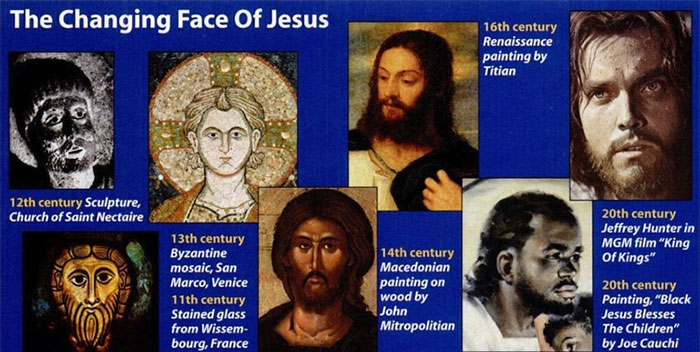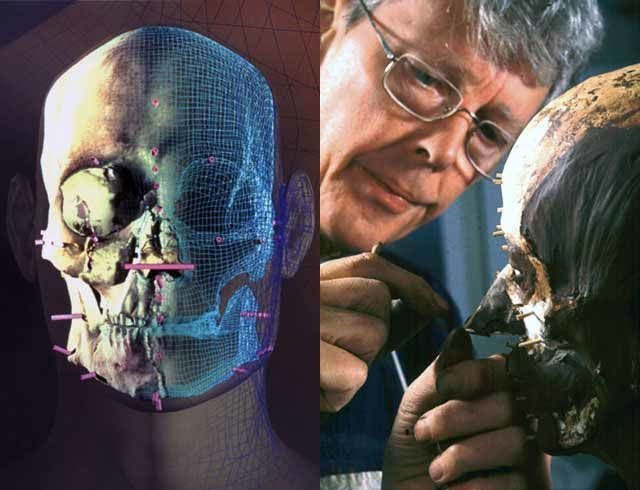Is this the true face of Jesus?
Jesus' face was created by forensic anthropologists, combining sources from archeology and the Bible.
In Western countries, Jesus is often described as a tall, thin body with long light brown hair, fair skin and bright eyes. Popular Mechanics says this is a familiar image, but it may not be accurate.
"It is a common image in Western countries. However, in some parts of the world, Jesus is depicted similarly to blacks, Arabs or Spanish", Carlos F. Cardoza -Orlandi, Associate Professor of Columbia Theological Institute in Atlanta, USA.

Different Jesus' faces in every part of the world from time to time.(Photo: Popular Mechanics).
Determined by forensic anthropological method
Similar to the way police sketch out criminal portraits, scientists in the UK, along with some Israeli archaeologists, have used forensic anthropology to recreate the face of Jesus.
Richard Neave, a medical expert who worked at the University of Manchester in the UK and led the research, thinks the method could help recreate Jesus' face in the most accurate way.
The apostle Matthew's description of the Gethsemane event provided some clues about Jesus' face. The facial features of the Lord bears many typical features of the Semites in that period.
So the first step in the Neave project and the team was to collect the skulls from Jerusalem, where Jesus lived and preached. The Semite skull was found by Israeli archaeologists and they were willing to share it with Neave's team.
With 3 specimens preserved from the time of Jesus in his hand, Neave used computerized tomography to reconstruct the skull. Combined with the use of special computer programs to calculate the thickness of the soft tissue on major areas of the human face, the team completed the reconstruction of the muscles and skin surrounding the Semite skull.

The team created a face from a skull found by the Semites.(Photo: National Geographic Image).
From this data source, the researchers created a 3D face rendering. Next, they created a fake skull. The layers of clay are covered on top of the corresponding thickness according to previous calculations from the computer. The nose, lips and eyelids are added according to the facial muscles.
The two most difficult factors yet to be determined are the length and color of the hair. To finalize, Neave's team referred to a number of drawings found at various archaeological sites. They date back to the first century.
These documents have helped researchers determine that Jesus' eyes are dark instead of blue, as is commonly described today. At the same time, Jesus also had a beard. Information about the length of hair is found in the Bible. Accordingly, scholars believe that Jesus had short hair and lots of curls.
Analysis of the skeletons also provides more information about height. Archaeologists firmly confirm that the average height of a Semite contemporary of Jesus is about 1.55 m. They weigh 50 kg. According to recorded records, Jesus worked outdoors as a carpenter. Therefore, the physique and muscularity of the Lord is more likely to be in balance than current Western portraits.
Accuracy of the above method
For those who are familiar with the portrait of Jesus through pictures or sculptures from the West, the image of the brown man appearing from Neave's laboratory will be extremely strange.

The face of Jesus was created by Neave's research team.(Photo: Popular Mechanics).
Neave also emphasized that the model created by his team simply refers to the representative appearance of an adult man, living at the same time and in the same place as Jesus.
'Forensic anthropology is not always accurate,' said Alison Galloway, a professor of anthropology at the University of California at Santa Cruz. 'The facial details are arranged in soft tissue above the muscle, where the forensic painters will show very differently depending on their techniques.'
Galloway said French painters will pay more attention to differences in details such as the distance between the bottom of the nose and mouth. Other facial features such as eye wrinkles, the structure of the nose or the shape of the mouth depend on the artist.
- Revealing the true face of Jesus
- Discovered a rare picture of Jesus' face more than 1,500 years old
- Revealing the true face of Jesus
- Admire the true content of Jesus
- Finding a rare face painting Jesus is more than 1,500 years old
- The face of Jesus appeared on the dish
- Restoring the face of a woman who was supposed to be the wife of Jesus
- The mystery of the healing ability of the towel that wipes Jesus' face
- Find new evidence that the true Jesus died from crucifixion
- The body of the skeleton reveals the life and death of Jesus
- The search for the living descendant of Jesus
- Clean wash for Turin shroud
- The shape of Jesus' tree was worshiped by Argentines
- Research reveals the shape of Jesus
 Discovered an ancient centipede fossil 99 million years old
Discovered an ancient centipede fossil 99 million years old Discovered bat-like dinosaurs in China
Discovered bat-like dinosaurs in China Discovered a 200-year-old bronze cannon of the coast
Discovered a 200-year-old bronze cannon of the coast Discover 305 million-year-old spider fossils
Discover 305 million-year-old spider fossils